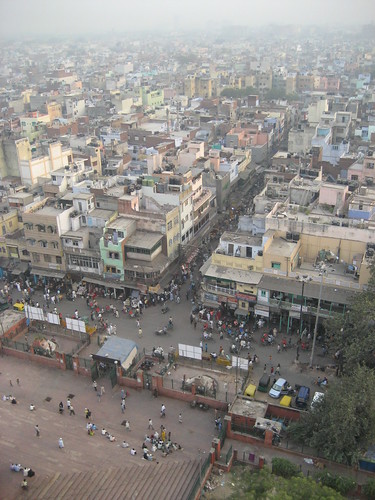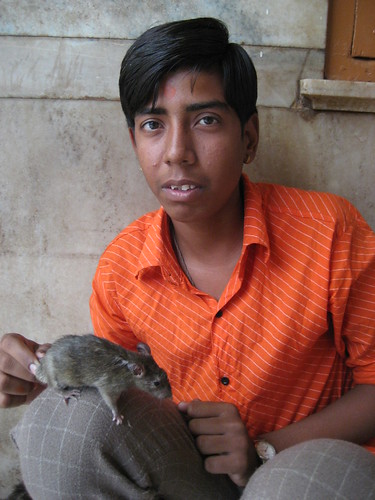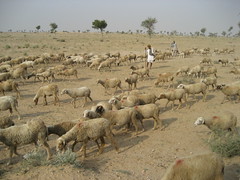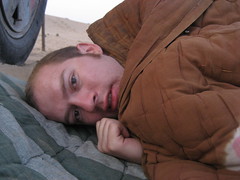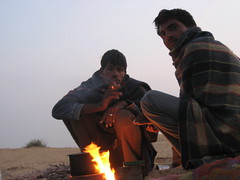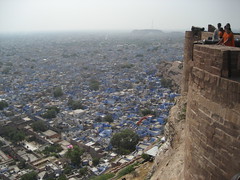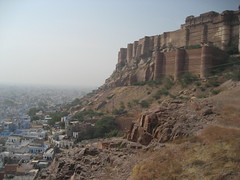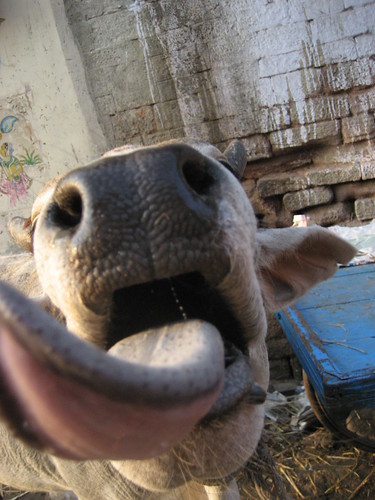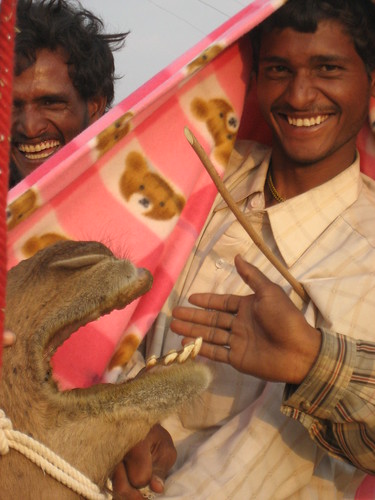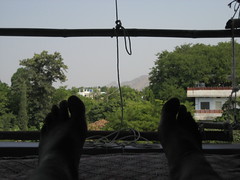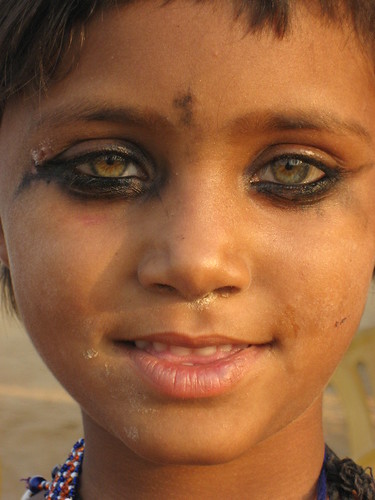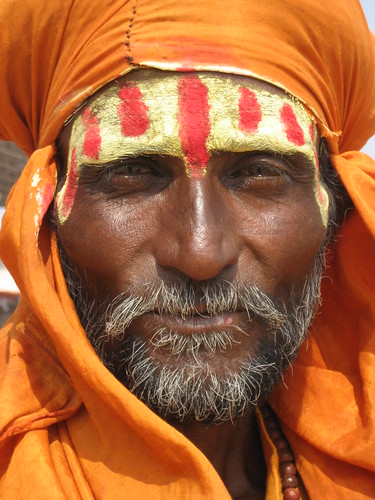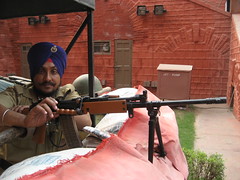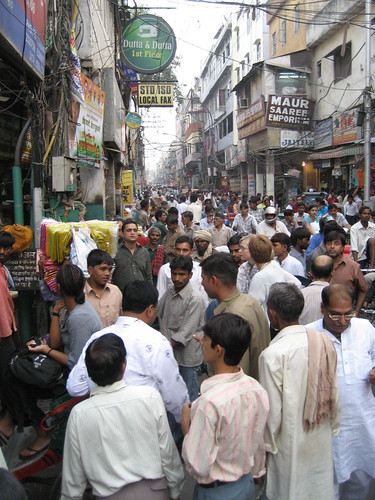The Burning Ghats
The city of Udaipur sits on gentle hills overlooking a sprawling lake, and its big claim to fame is that the James Bond movie Octopussy was filmed here. The hills and winding streets reminded me of San Francisco, and the narrow alleys and relationship to the water reminded me of Venice, which when added to the distinctly Indian flare, made for a nice combination. Like in most Indian cities, the streets were dotted with people, rickshaws, goats, trucks, cows, cars, dogs, and even the occasional elephant. My hotel had a radical rooftop from which I ate superb home cooked meals and watch the sunset over the lake every night. It's also a stone's throw away from almost every area where they shot Octopussy, a movie which was filmed in Udiapur, in case you forgot to read that earlier.
Laundry and the lake palace:
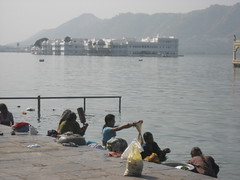
Lal Ghat, the area where my hotel was:
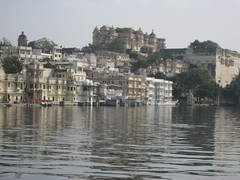
Taking a break from the fort-temple-temple-fort-fort-temple routine, I decided to enroll in a few classes while in Udaipur. My two hour Indian cooking class was great, and I learned how to make some phenomenal vegetarian food including spicy paneer butter masala and everyone's flatbread favorite tandoori naan.
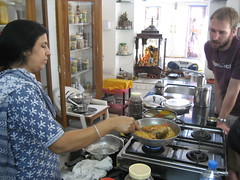
I also took a tabla drum lesson, which wasn't quite as good as the cooking class — my creepy instructor Krishna kept trying to sell me drums the whole time and informed me that I "play the tablas like a child." A one hour lesson only set me back about four dollars and I learned the basics, so I tolerated the humiliation.
My favorite sight in the city was definitely the Udaipur Maharana's collection of classic cars, which has been converted into a small indoor/outdoor museum for visitors. Unlike most guys, I'm not really crazy about cars, but I guess the Maharaja had good taste and he amassed what I thought was an amazing collection. There were more than 50 cars total including a flawless Model T Ford, some curvy Cadillacs from the '60s, and a couple of 1930s-era cars made by Rolls Royce. They even had the shiny black Rolls Royce Phantom III that bad guy Kamal Kahn drove around in Octopussy. Did I mention they filmed that movie here? The ticket price even came with an oddly-named "antique cold drink" which was a Coke which tasted like it too had been preserved since the '30s.
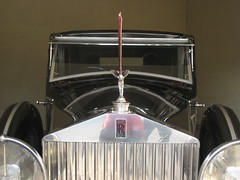
One of the dominating features in the area near the lake is the intricately carved Jagdish Temple, which was built in 1651. It can be seen in a few scenes of the James Bond movie Octopussy, which was filmed in Udaipur. Did you know that? The temple was great, but I enjoyed the courtyard outside more, which was full of some great photo ops of sunbaked saddhus.
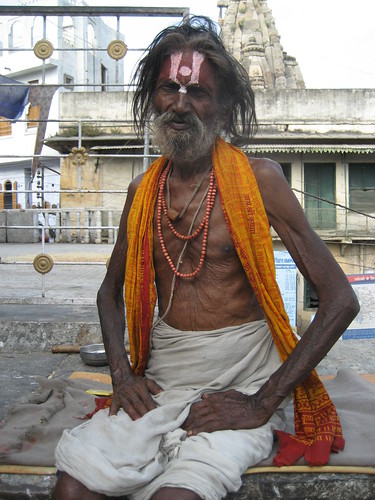
On my third day, I finally broke down and took part in my hotel's awkwardly named "Nightly Octopussy Show" — hearing about the movie from shop owners all the time and not having seen it was driving me nuts. A word to the wise: don't ever watch Octopussy. It was easily one of the most ridiculous and awful movies I've ever seen, and I like almost everything — I even liked Highlander Endgame and the Super Mario Brothers Movie. This was that bad, folks. It was kind of fun to see Udaipur in the movie, and I was amazed at how little the city has changed in the last 30 years, but it was still excruciating to sit through all two hours of the awful film. And the funny part is that they refer to Udiapur as "Delhi" in the movie. Ouch! How do you like that, Udaipur!? Not so famous now, are you?
My last stop in peaceful Udaipur was the Bagore-Ki Haveli, which has been recently converted into a museum full of hit-and-miss local contemporary art, and some pretty interesting recreations of what the mansion might have been like in its heyday. The most shocking thing to me was the complete segregation of men and women in the house — separate bedrooms, separate sitting rooms, separate bathrooms, and separate game rooms. Men and women couldn't even play chess with each other in those days. Unfortunately, not much appears to have changed in modern India. The haveli is also home to the world's largest turban, which was about five wide, even though it doesn't look like it in this picture:
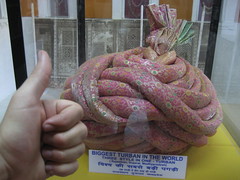
I left Udaipur headed for Agra on an overnight sleeper bus, which is probably my favorite way of getting around India. It only costs around a dollar or two more than a seat and you get your own tiny compartment which hovers just inches above the heads of the people sitting below.
In 1997, when the Frank Gehry's Guggenheim Museum in Bilbao was finished, the city transformed from a gritty industrial hub into a modern, world-class city virtually overnight. The city-changing quality the building had on the Spanish town was dubbed "The Bilbao Effect," and cities today strive for the same thing to happen to them. The Indian city of Agra is the reason why it's not called "The Agra Effect." Sure, it's got a great building. Possibly the greatest building on earth: The Taj Mahal. But the rest of the city is a total dump. Even the locals seemed to think so — when I told people I was staying for two days, they said it was one day too long. Yikes.
My first night in Agra, I headed across the river for views of the back of the Taj at sunset. In some odd fluke of city planning, there's nothing on the other side of the river except muddy banks covered in dilapidated villages, water buffaloes, stray dogs, and a handful of five-year-olds selling postcards. The capitalist American in me couldn't believe that land with million-dollar views had remained undeveloped, but it was neat to see a rural village in such close proximity to a city.
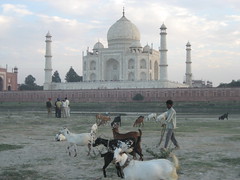
The next morning, I woke up well before sunrise and was third in line for the Taj. Travelers all around India complain about the excessive ticket price to get in — about 16 dollars. Word on the traveler rumor-mill is that Bill Clinton visited a few years back when the price was only a couple bucks, and mentioned that they could make a killing if they raised the ticket prices, so they increased it by a thousand percent. First Monica Lewinsky and now this. Way to go, Bill.
After forking over the cash, I finally made it inside and caught my first closeup glimpse of the stunning Taj Mahal. Completed in 1653, the building was commissioned by Emperor Shah Jahan to memorialize his second wife, who died during childbirth. His first wife received nothing but divorce papers. Probably because it's the most photographed building on earth, the Taj is one of the few places I've seen that looks exactly like I had pictured. With that said, it still was incredibly impressive, and I spent a few hours just hanging out staring at it as the sun came up and made the white marble glow.
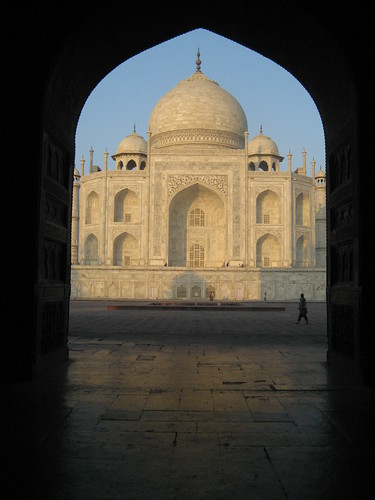
Sick of sightseeing, I didn't accomplish much else in Agra before my long night train eastward to the holy city of Varanasi. The city is the major religious center of Hindu India, and it sits famously along the holy water of the Ganges River (pronounced gone-guh), which Hindus believe has healing powers. The reality of the river is probably the opposite, however, because the water is some of the most polluted on earth. Travelers like to quote the most awful statistic: the amount of fecal matter in the river is nearly 2000 times higher than safe levels for bathing. Still, that doesn't keep the holy from diving in and the locals from playing in the dangerously septic water. And you thought the rat temple was gross.
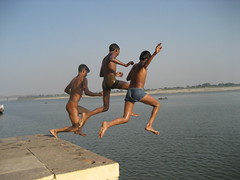
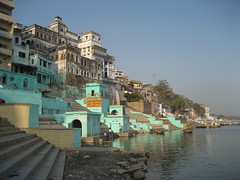
Except for the occasional nasty whiff of the river, walking along the ghats of Varanasi is an incredible experience. There are more than 50 ghats—the name for the sets of steps leading down into a river—and each one has its own personality. Some are specifically for bathing, some are used for doing laundry, some are infested with water buffaloes, some serve as home to stray dogs, some are calm and vacant, some and some are full of travelers and beggars. And two—known as the burning ghats—are where bodies are carefully submerged into the river's holy water before they are placed on logs and burned into ashes.
At first, you see the smoke. Then, along the stairs leading down into the river, you see piles and piles of logs. Then you see the workers, whose faces are covered in sooty rags. Then you see the mourning families. Then, the burning bodies.
I watched one woman—completely covered in fabric and flowers—placed upon sandalwood logs. Her son took a torch and ceremonially made a circle around his dead mother five times until he finally stuck the torch at the bottom of the bed of logs. The fabric around her began to turn black, and the outline of her body—once clearly recognizable as a person—started to erode as it burned. The family walked away and did their best to hold back their tears because crying is seen as bad luck and disrespect to the dead. Along the rest of the ghat, the same process was being played out a dozen times over. It's hard for me to accurately describe or analyze the experience, but I will say that I was surprised at how emotional I got watching all of that take place. Witnessing death in the form of human bodies burning was something that affected me and deeply resonated with me as a sight I'll not soon forget.
Away from the ghats, Varanasi is equally amazing. In the old city, the maze-like alleyways are the most narrow and confusing yet, and at night they turn into a lively market of souvenirs, open-air restaurants, paan wallahs, colorful bangle shops, and more. You have to watch your step, however — poorly-lit areas are like a cow shit minefield and one misplaced step could spell disaster. The traffic in Varanasi is definitely the most intense I've seen so far. The air in the streets vibrates with the clanging of hundreds of cycle rickshaw bells, covered in an earsplitting layer of motorcycle and car horns. Crossing the street is an act reserved for the stupid or the brave. A few quick videos of typical street scenes:
On my last morning, I went on an early morning boat ride along the Ganges with Sam and Brad, a delightful American couple that I kept bumping into the previous week. We lit candles, put them in banana leaf boats and put them into the water to float down the holy river. The city looked spectacular in the pre-dawn light, and the three of us all loved the hour-long trip.
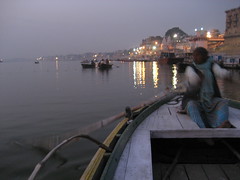
I left Varanasi mid-afternoon on my last Indian train bound for Calcutta. I met some really cool Japanese and Korean guys on the train — one guy has spent the last five years snowboarding, traveling, and working short-term jobs as he follows winter around the globe in search of the world's best snowboarding runs. I arrived in Calcutta—currently known as Kolkata—and hopped on a 5-cent commuter ferry across the Hoolighy River, where I checked into Hotel Paragon, a fantastic guesthouse where mostly Korean and Japanese travelers had epic hangout sessions in the courtyard, playing guitars and singing Beatles songs. The main traveler area along Sudder Street has the distinct feel of a highly detailed movie set. Old-fashioned, bright yellow cabs move down streets lined with British-era buildings. Out of all the "traveler ghettos" in India, Sudder Street was definitely my favorite.
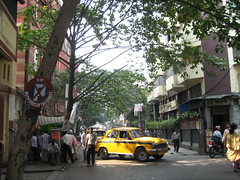
I spent my three days in Calcutta going to museums and art galleries. Museums in the city—and throughout the rest of India—are unbelievably sketchy and look like they were built, but never maintained, cleaned, or updated. I kept thinking of them as "museum museums," exploring the quirks and oddities of Indian exhibit design throughout the last century.
The first stop on my run-down museum tour was the Indian Museum, which was the city's version of the Museum of Nature and Science in Denver. My favorite room was the dusty "Plants in Service of Man" exhibit, which documented all the uses for plants in society. Did you know plants can grow things called vegetables, which we humans can eat? Or, did you know that trees produce something called wood, which we can use to build things like rickshaws or huts? I know, I was amazed too. In a different part of the museum, I was impressed with the lifelike sound effects of an aviary diorama, but then I realized it was just because real birds had actually made a nest there. Huh.
Somehow, the science museum was even more sketchy. It was meant to be an interactive and fun place for kids to learn about science, but thanks to India's thou-shalt-not-maintain-anything policy, many of the exhibits were broken. The ones that were working were often weird, or occasionally downright creepy. Take this exhibit called "Try to Touch the Doll's Head!," which demonstrated motion sensor technology. Kids are challenged to touch this doll's head before the motion sensor goes off and it drops down into a hole. I didn't know science was supposed to give kids nightmares.
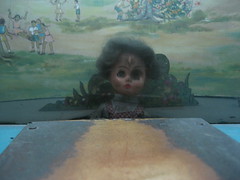
In addition to the weird museums, I also made it to some great sights in Kolkata. The CIMA Gallery, although small, had a phenomenal contemporary painting and sculpture exhibition with several pieces by five local artists. All of the art revolved in some way around the theme of Bengal's mixed Anglo-Indian culture, and I left the exhibit inspired. I also visited the Park Street Cemetery was also an interesting look at the monumental gravestones of long-gone leaders of the East India Company, which dominated these parts during colonial India.
My last full day in India, I headed to the biggest theatre I could find to watch Dhoom 2, the action-packed Bollywood blockbuster that's out right now. One of the few things I knew about Bollywood is that they release the songs from the movie well before the movies hit theatres so that people can sing along and get really into the movies as they're watching them. Sure enough, I somehow knew a few of the songs just because I've been in India for a few months. The whole movie was in Hindi, so it was a little bit confusing, but I understood most of what was going on. Actually, I guess you could say the movie was in Hinglish, the weird Hindi-English crossover language spoken by the Indian upper middle class. Dialogue went something like this:
Oh my god! Hindi hindi hindi hindi hindi hindi. That's so cool, man! Hindi hindi hindi hindi hindi hindi hindi hindi hindi hindi hindi hindi hindi is all that I've ever wanted. Hindi hindi hindi hindi hindi. Oh, I know darling! Hindi hindi hindi.
Dhoom 2 is extremely controversial right now in India, because it features a kiss between respectable actors Aishwarya Rai and Hrithik Roshan — apparently it is the first actual kiss in a major Hindi movie. Scandalous! Anyway, the movie was silly and over the top, but a really fun cultural experience.
My two-month India tour complete, I parted with the chaos and boarded an airplane last night headed for Thailand. I'm in Bangkok right now, looking out the window of an Internet cafe as the afternoon rain pummels the streets. I got here this morning, and I'm loving it so far. Tomorrow morning I'm off to the airport to pick up my friend Gerni, who will be traveling with me for the next few months around Southeast Asia. Thanks for reading this whopper of a post.
Ryan!
Photos (finally) updated: Bikaner, Jaisalmer, Jodhpur, Udaipur, Agra, Varanasi. I also added the short street party video to the last post.
